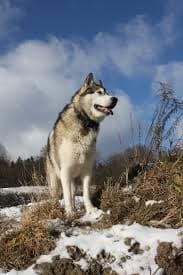Alaskan Malamute

Height
Male: 58-64 cm, Female: 58-64 cmWeight
Male: 34-45 kg, Female: 34-45 kgPedigree
YesLifespan
12 to 15 yearsPros
- Loyal
- Affectionate with family
- Intelligent
- Playful
- Good endurance
- Can be good with children (when properly socialized)
- Relatively quiet (doesn't bark excessively)
- Impressive appearance.
Cons
- High exercise needs
- Strong prey drive
- Prone to digging
- Sheds heavily (twice a year)
- Can be stubborn and independent
- Potential for aggression towards other animals (especially same-sex)
- Needs experienced owner
- Can be destructive if bored
- Prone to certain health problems (hip dysplasia
- chondrodysplasia
- progressive retinal atrophy)
- Not a good choice for apartment living
- Requires extensive socialization
Introduction of the Alaskan Malamute
The Alaskan Malamute is a majestic and powerful breed, known for its incredible strength, endurance, and gentle temperament. Originally bred as a working dog by the Mahlemut Inuit people of Alaska, these large, fluffy canines excel in harsh Arctic conditions, where they were used to haul heavy sleds over long distances. Despite their imposing size, Alaskan Malamutes are renowned for their friendly and sociable nature, making them wonderful companions for active families and individuals who can meet their exercise needs.
Alaskan Malamutes are loyal and affectionate, often forming deep bonds with their owners. Their thick, double-layered coats—perfect for keeping them warm in frigid climates—come in a variety of striking colors, including shades of gray, black, red, and white. While they are not as agile as smaller breeds, their dignified presence and unwavering determination make them stand out. With proper training and socialization, these dogs become loving, dependable members of the household, always eager to join in on outdoor adventures.
History of the Alaskan Malamute
The Alaskan Malamute traces its origins back thousands of years to the indigenous Mahlemut people of Alaska, who relied on these dogs for survival in the unforgiving Arctic environment. Bred for their strength and stamina, Malamutes were tasked with pulling heavy loads across snow and ice, transporting supplies, and assisting in hunting. Their development was shaped by the need for a hardy, resilient dog capable of thriving in extreme cold, which is reflected in their robust build and thick fur.
During the Klondike Gold Rush of the late 19th century, Alaskan Malamutes gained attention as sled dogs, helping prospectors navigate the rugged Alaskan terrain. However, their numbers dwindled as crossbreeding with faster dogs became common. The breed faced near extinction in the early 20th century but was preserved through dedicated efforts by enthusiasts. In 1935, the American Kennel Club officially recognized the Alaskan Malamute, establishing a breed standard that emphasized their working heritage and striking appearance.
Today, Alaskan Malamutes are celebrated not only for their historical significance but also as loyal family pets and impressive show dogs. While they no longer serve as primary working dogs in most places, their legacy as tireless laborers lives on, and they remain a symbol of resilience and companionship in cold climates around the world.
Interesting facts about the breed
- Alaskan Malamutes are one of the oldest Arctic sled dog breeds, with a history dating back over 4,000 years.
- They were bred for strength rather than speed, unlike their Siberian Husky cousins.
- Malamutes have a strong pack mentality and thrive in social environments with humans or other dogs.
- Their thick coats require regular grooming to prevent matting, especially during shedding seasons.
- They are known for their "woo-woo" vocalizations, often "talking" to express themselves.
- Alaskan Malamutes have a high prey drive and may chase smaller animals if not properly trained.
Characteristics
Apartment Suitable
Beginner Friendly
Hardiness
Independence
Tolerates Cold
Tolerates Hot
Friendliness
Affectionate With Family
Kid Friendly
Dog Friendly
Stranger Friendly
Grooming
Shedding
Drools
Ease of Grooming
Health
Gains Weight
Ease Of Training
Intelligence
Prey Drive
Vocality
Wanderlust
Need for Attention
Activeness
Intensity
Excercise Needs
Are you looking to buy the Alaskan Malamute breed?
See current available pets or share this breed with your friends!